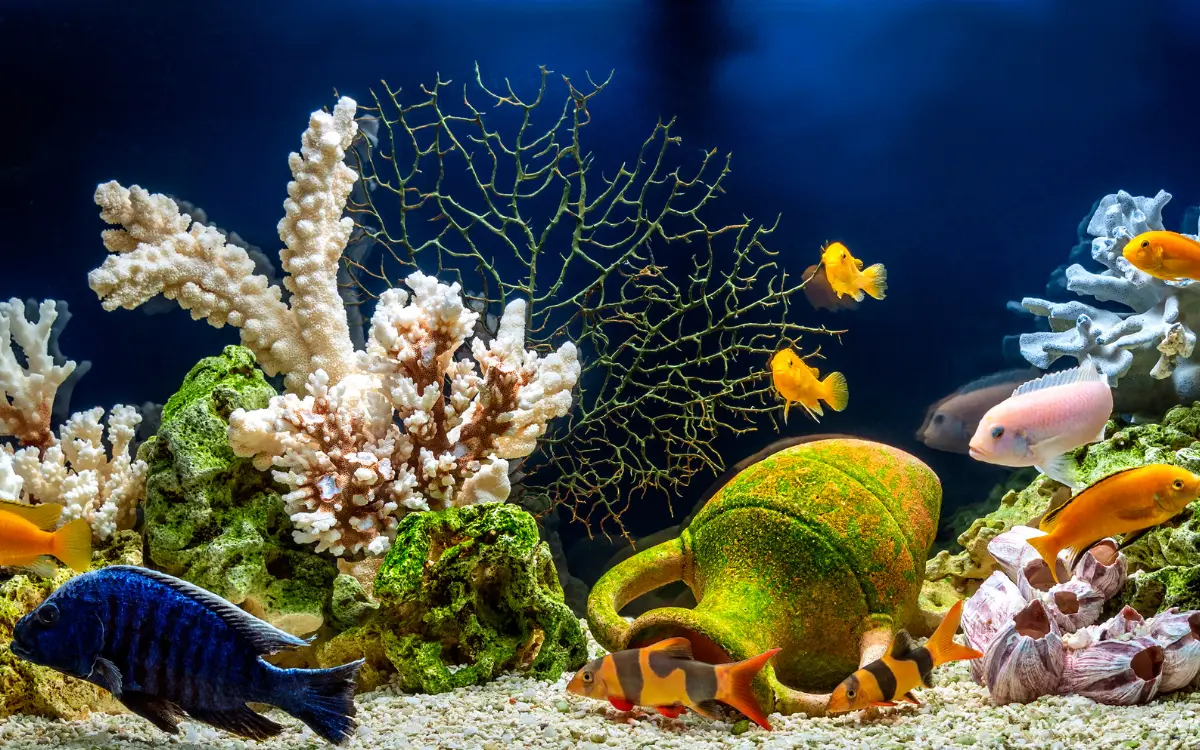Setting up a freshwater aquarium is an exciting adventure that brings the beauty and tranquility of the underwater world into your home.
Whether you’re new to the hobby or have some experience, this guide will help you with everything you need to know.
From picking the right tank and equipment to understanding the needs of different fish, we’ll cover it all. Get ready to dive into the peaceful and fascinating world of freshwater aquariums.
What is a Freshwater Aquarium?
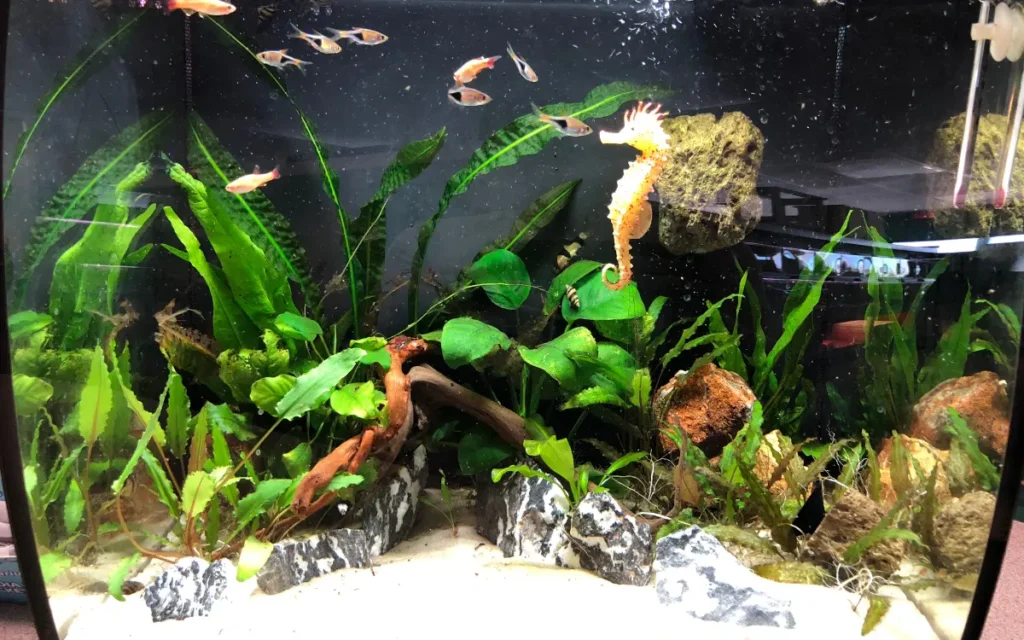
A freshwater aquarium is a self-contained ecosystem designed to house freshwater species of fish, plants, and other aquatic life.
These aquariums can range from small desktop tanks to large, elaborate setups and offer numerous benefits, including stress relief, educational value, and a unique way to engage with nature.”
Benefits of Having a Freshwater Aquarium
Freshwater aquariums offer stress relief, educational opportunities, and a way to connect with nature. They also enhance the aesthetic appeal of any space.
Types of Freshwater Aquariums
1.Community Tanks
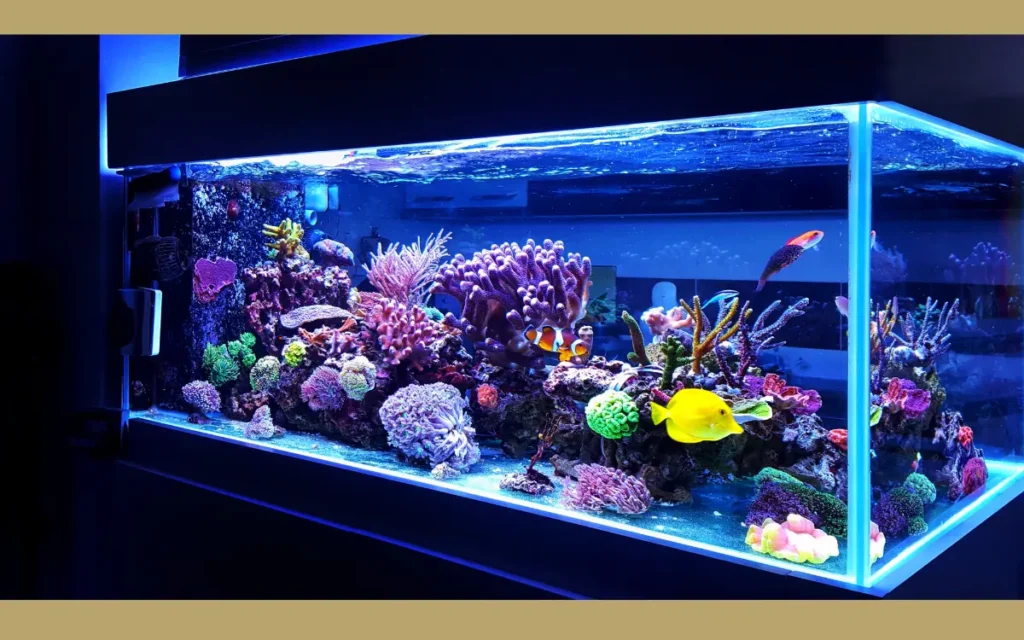
- Description: Houses a variety of compatible fish species.
- Benefits: Diverse and lively environment, visually appealing, easy to set up.
2.Species-Specific Tanks

- Description: Dedicated to one species of fish.
- Benefits: Easier to meet the specific needs of one species, reduces aggression, better breeding environment.
3.Biotope Tanks
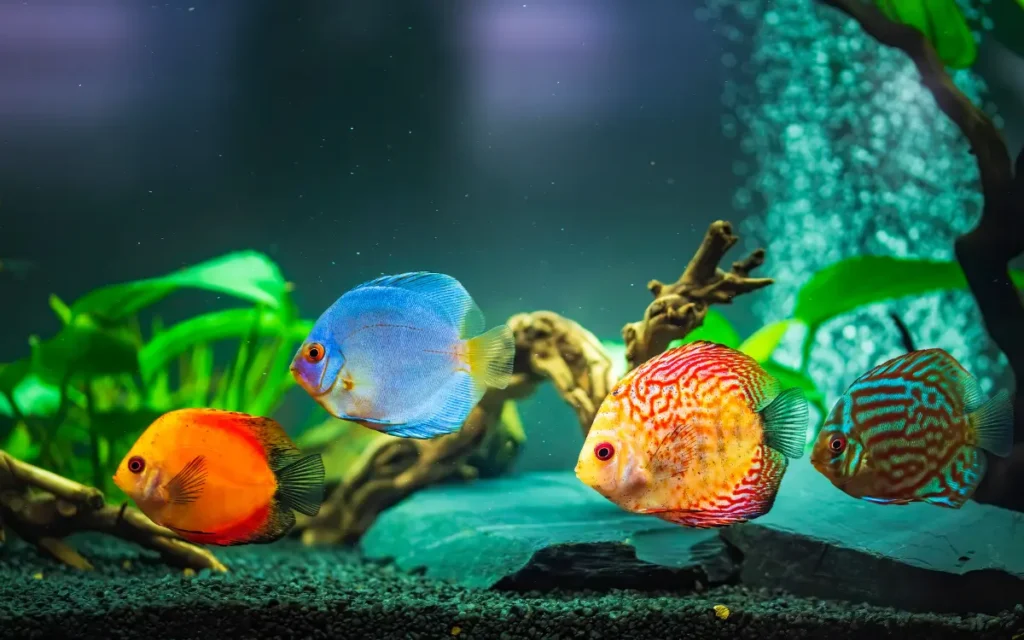
- Description: Mimics a specific natural habitat.
- Benefits: Provides a natural and authentic environment for fish, educational, visually unique.
4.Planted Tanks
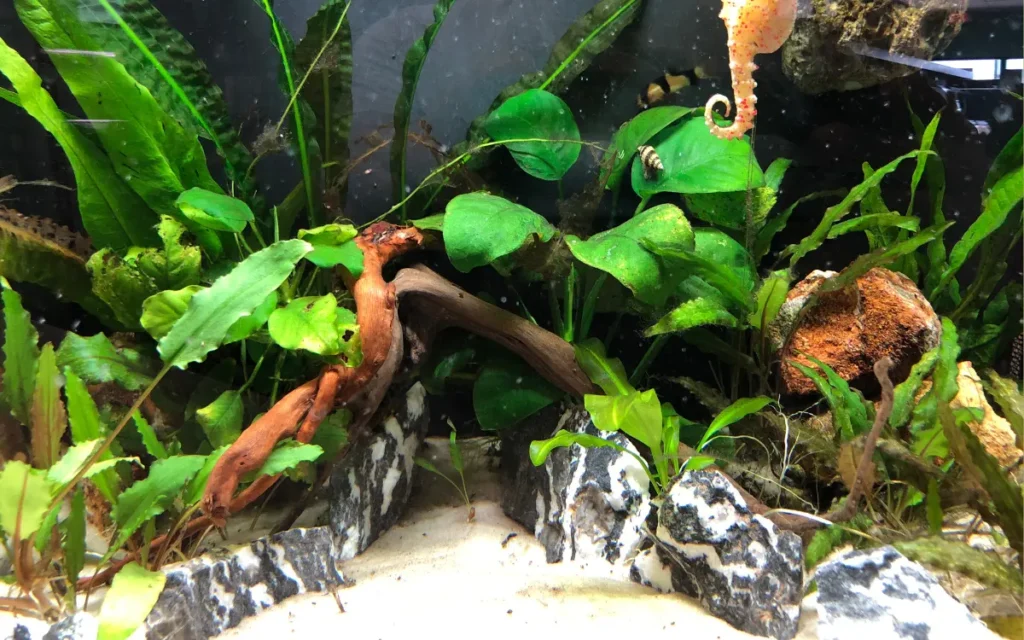
- Description: Focuses on growing aquatic plants.
- Benefits: Enhances water quality, creates a beautiful and lush environment, beneficial for fish health.
Selecting Your Aquarium
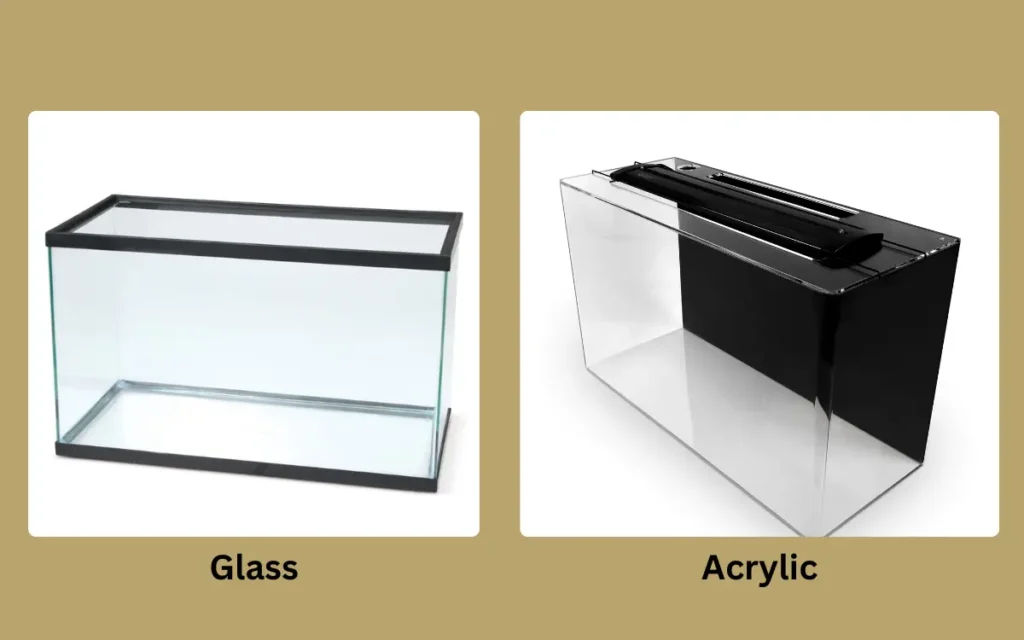
When selecting an aquarium, consider the size and shape that fits your space and the type of fish you want to keep. Larger tanks are generally more stable and easier to maintain.
Materials: Glass vs. Acrylic
- Glass Tanks: Durable, scratch-resistant, and less likely to discolor over time. They are heavier and can break if mishandled.
- Acrylic Tanks: Lighter, more impact-resistant, and provide better insulation. They are more prone to scratching and can be more expensive than glass tanks.
Read also:
- Brackish Water Aquariums: Setup And Species
- Saltwater Aquariums: Setup, Types, And Maintenance
- Theme-Based Aquariums: Showcase, Breeding, And Quarantine Setups
- Aquarium Sizes And Shapes: Choosing The Right Tank For Your Needs
Location and Placement Considerations
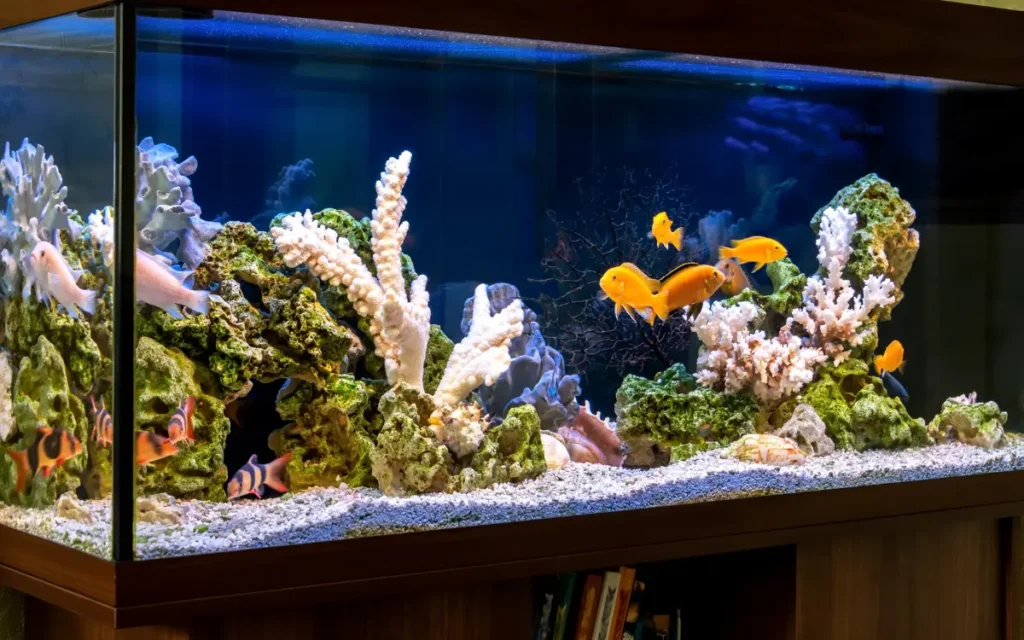
Sturdy Stand: Ensure your tank is placed on a stand that can support its weight when filled with water and decorations.
Away from Direct Sunlight: Place the tank away from direct sunlight to prevent algae growth and temperature fluctuations.
Accessibility: Choose a location where you can easily access the tank for maintenance, feeding, and enjoying the view.
Electrical Outlets: Make sure the tank is near electrical outlets for equipment like filters, heaters, and lights.
Essential Equipment for Freshwater Aquarium
Filtration Systems
Types:
- Hang-on-Back (HOB) Filters: Easy to install and maintain, suitable for most tank sizes. They provide mechanical, chemical, and biological filtration.
- Canister Filters: Ideal for larger tanks, offering superior filtration capacity and flexibility. They can be customized with various filter media.
- Sponge Filters: Gentle on fish, especially useful for breeding tanks and shrimp tanks. They provide excellent biological filtration.
- Internal Filters: Compact and versatile, good for small tanks and additional filtration in larger tanks.
Benefits: Keeps the water clean and clear, removes toxins, provides a healthy environment for fish, and supports beneficial bacteria growth.
Heaters and Thermometers
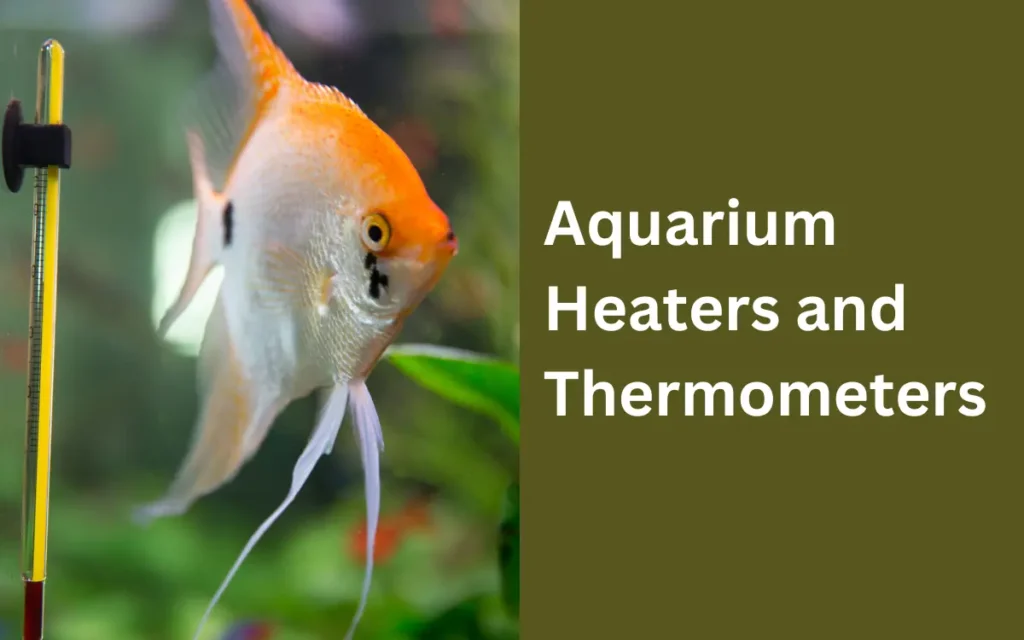
Types:
- Submersible Heaters: Placed inside the tank, they offer consistent and reliable heating. Easy to adjust and monitor.
- External Heaters: Installed outside the tank, often used in conjunction with canister filters. They provide uniform heating without taking up space inside the tank.
- Benefits: Maintains stable water temperature, crucial for the health and well-being of tropical fish. Thermometers help monitor the temperature to ensure it stays within the ideal range.
Lighting
Types:
- LED: Energy-efficient, long-lasting, and customizable. Offers a variety of color spectrums to enhance tank appearance.
- Fluorescent: Provides good illumination for plant growth, commonly used in freshwater tanks.
- T5HO: High-output fluorescent lights, ideal for heavily planted tanks requiring intense light.
- Benefits: Promotes plant growth, enhances the colors of fish and decorations, and mimics natural daylight cycles to support fish health.
Substrate and Decorations
Types:
- Gravel: Easy to clean, provides a good surface for beneficial bacteria to colonize. Comes in various colors to suit tank aesthetics.
- Sand: Natural appearance, suitable for bottom-dwelling fish. Supports plant growth and is gentle on fish that dig.
- Aquarium Soil: Nutrient-rich, ideal for planted tanks. Enhances plant growth and helps maintain water chemistry.
- Benefits: Substrates provide a base for plants, support beneficial bacteria, and create a natural habitat. Decorations like rocks, driftwood, and artificial plants offer hiding spots and territories for fish, reducing stress and enhancing the tank’s visual appeal.
Setting Up Your Aquarium
Set up your aquarium by cleaning the tank, adding substrate and decorations, installing the filter and heater, and filling it with water. Ensure all equipment is functioning properly before adding fish.
Cycling the Tank
Cycling the tank is essential to establish a healthy environment for fish. This involves creating a beneficial bacterial colony that breaks down waste products. Monitor ammonia, nitrite, and nitrate levels during this process.
Fishless Cycling vs. Fish-in Cycling
Fishless Cycling:
- Method: Adding an ammonia source (like pure ammonia or fish food) to the tank without any fish.
- Benefits: Safe and stress-free for fish, allows beneficial bacteria to establish before introducing fish.
Fish-in Cycling:
- Method: Introducing a few hardy fish to produce ammonia, with frequent water monitoring and changes.
- Benefits: Can be quicker, but requires careful monitoring to protect the fish from ammonia and nitrite toxicity.
Monitoring Water Parameters
Key Parameters:
- Ammonia: Should be kept at 0 ppm (parts per million). Toxic to fish.
- Nitrite: Should be kept at 0 ppm. Also toxic to fish.
- Nitrate: Should be kept below 20-40 ppm. Less harmful, but high levels can stress fish and promote algae growth.
- Benefits: Regular testing ensures the tank is cycling correctly and helps in making timely adjustments to maintain a safe environment for fish.
Regular Water Changes
Steps: Perform partial water changes (10-25%) weekly to remove excess nitrates and other waste products. Use a gravel vacuum to clean the substrate.
Benefits: Maintains water quality, reduces toxin buildup, and provides a healthier environment for fish. Helps to keep the tank clean and clear, supporting overall fish health and well-being.
Water Parameters and Maintenance
Testing Water Quality
Maintaining proper water parameters is crucial for a healthy aquarium. Perform regular water changes, clean the tank and equipment, and monitor water quality to ensure a stable environment.
Ideal pH, Hardness, and Temperature Ranges for Different Fish
pH: Most freshwater fish thrive in a pH range of 6.5 to 7.5. Some species may require more specific pH levels.
Hardness: General hardness (GH) and carbonate hardness (KH) should match the needs of your fish. For example, soft water fish prefer GH below 8 dGH, while hard water fish thrive above 12 dGH.
Temperature: Common tropical fish typically prefer temperatures between 72-82°F (22-28°C). Check specific requirements for each species.
Benefits: Maintaining ideal water conditions promotes fish health, reduces stress, and enhances growth and coloration.
Regular Maintenance Routines
Water Changes: Perform partial water changes (10-25%) weekly to remove waste and replenish essential minerals. Use dechlorinated water to avoid harming fish.
Cleaning the Tank and Equipment: Regularly clean the tank walls, substrate, and decorations. Rinse filters in tank water (not tap water) to preserve beneficial bacteria.
Managing Algae Growth: Control light exposure, avoid overfeeding, and introduce algae-eating fish or snails. Clean algae off the tank walls and decorations as needed.
Benefits: Regular maintenance ensures a healthy and stable environment, preventing toxin buildup, promoting clear water, and keeping the tank aesthetically pleasing. It also helps to avoid common problems such as algae overgrowth and poor water quality.
Selecting Fish for Your Aquarium
Research and select fish that are compatible with each other and your tank’s conditions. Create a balanced community by considering factors such as size, temperament, and habitat requirements.
Beginner-Friendly Fish Options
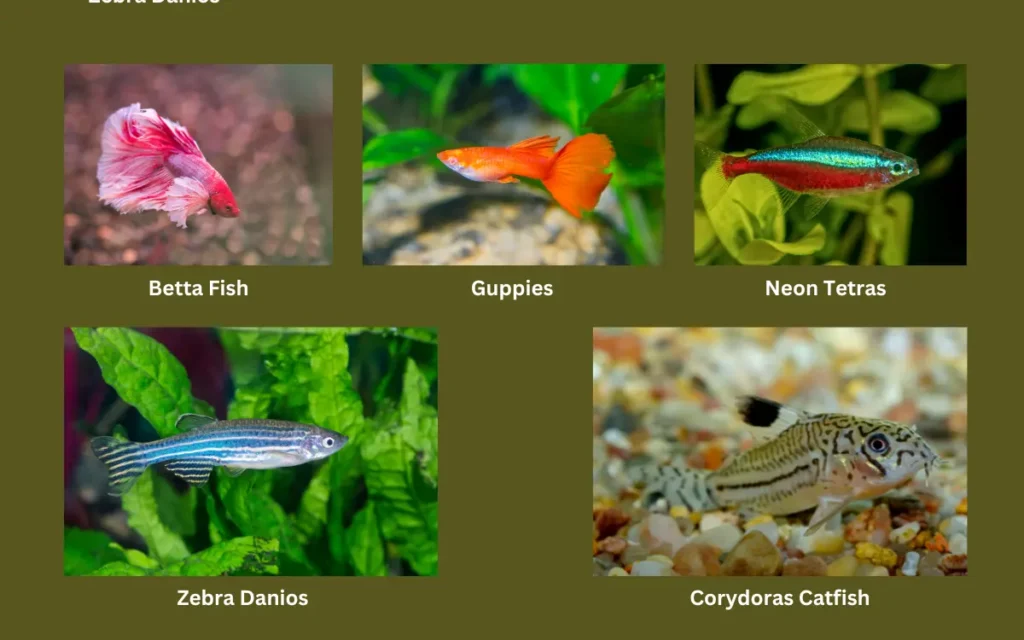
I recomended This fish For Beginner:
Betta Fish: Hardy and colorful, suitable for small tanks.
Guppies: Easy to care for, come in a variety of colors, and breed readily.
Neon Tetras: Peaceful and vibrant, great for community tanks.
Zebra Danios: Hardy and active, ideal for beginners.
Corydoras Catfish: Gentle bottom-dwellers that help keep the tank clean.
Benefits: These species are resilient, easy to care for, and adapt well to a range of conditions, making them ideal for those new to fishkeeping.
Creating a Balanced Fish Community
- Steps: Select a mix of fish that occupy different levels of the tank (top, middle, bottom) and have compatible temperaments. Consider adding a mix of species that offer different benefits, such as algae eaters or bottom dwellers.
- Benefits: A balanced fish community creates a more dynamic and interesting tank environment, reduces territorial conflicts, and ensures all areas of the tank are utilized. It also helps maintain the tank’s health by having fish that contribute to cleaning and algae control.
More about Freshwater water fish read this:-26 Best Freshwater Fish for Your Aquarium
Introducing Fish to Your Aquarium
Proper Acclimation Process
Steps:
Float the Bag: Place the sealed bag with the fish in your aquarium for 15-20 minutes to equalize the temperature.
Add Tank Water: Open the bag and add a small amount of tank water to it. Repeat this every 5-10 minutes for about an hour.
Release the Fish: Gently net the fish out of the bag and place them into the tank. Avoid pouring the bag water into the aquarium.
Benefits: Gradual acclimation reduces stress and prevents shock, helping the fish adjust to their new environment safely.
Monitoring Fish Health and Behavior
Steps:
Observe Daily: Check for signs of stress or illness such as erratic swimming, clamped fins, or changes in appetite.
Check Water Parameters: Regularly test ammonia, nitrite, nitrate, pH, and temperature to ensure they are within acceptable ranges.
Quarantine New Fish: If possible, quarantine new fish for 2-4 weeks before adding them to the main tank to prevent the spread of disease.
Benefits: Early detection of health issues allows for timely intervention, maintaining a healthy and thriving aquarium.
Avoiding Overstocking
Guidelines:
1 Inch of Fish per Gallon: A general rule is to have no more than 1 inch of fish per gallon of water. Adjust this based on the fish’s needs and behavior.
Research: Understand the adult size, activity level, and social behavior of the fish species you plan to keep.
Provide Space: Ensure there is enough space for swimming and hiding, and maintain good water quality with adequate filtration.
Benefits: Prevents overcrowding, reduces stress, and helps maintain water quality, promoting a healthy environment for all aquarium inhabitants.
Caring for Your Aquarium
Feeding Fish Properly
| Step | Action | Tips |
| 1 | Choose the right food | Select food suitable for your fish species (flakes, pellets, frozen, live). |
| 2 | Feed the right amount | Offer only as much food as the fish can consume in 2-3 minutes, once or twice a day. |
| 3 | Vary the diet | Include a mix of different foods to ensure balanced nutrition. |
| 4 | Remove uneaten food | Siphon out any uneaten food to prevent water contamination. |
Recognizing and Treating Common Fish Diseases
| Disease | Symptoms | Treatment |
| Ich (White Spot Disease) | White spots on body and fins, scratching against objects | Raise tank temperature gradually to 82-86°F, add aquarium salt, and use anti-parasitic medication. |
| Fin Rot | Ragged or disintegrating fins, inflammation at fin base | Improve water quality, add aquarium salt, and use antibacterial medication. |
| Swim Bladder Disease | Difficulty swimming, floating or sinking | Feed peas (for constipation), fast the fish for a few days, and improve water conditions. |
| Fungal Infections | White, cotton-like growths on body or fins | Use antifungal medication, improve water quality, and remove affected fish if necessary. |
| Columnaris | White or grayish patches, frayed fins, mouth fungus | Improve water quality, reduce stress, and use antibacterial medication. |
Maintaining a Healthy Aquarium Environment
| Task | Frequency | Action |
| Water Changes | Weekly | Replace 10-25% of the tank water with dechlorinated water. |
| Filter Maintenance | Monthly | Rinse filter media in tank water, replace as needed. |
| Substrate Cleaning | Bi-weekly | Use a gravel vacuum to remove debris and waste. |
| Water Testing | Weekly | Test for ammonia, nitrite, nitrate, pH, and hardness. |
| Algae Control | As needed | Clean algae from glass, decorations, and plants. Use algae eaters if necessary. |
| Equipment Check | Monthly | Inspect and clean heaters, filters, and other equipment. |
Aquarium Plants
Benefits of Live Plants
| Benefit | Description |
| Oxygenation | Live plants produce oxygen during photosynthesis, improving water quality for fish. |
| Natural Filtration | Plants absorb nitrates and other toxins, helping to maintain a balanced and clean environment. |
| Algae Control | Competing with algae for nutrients, live plants can help reduce algae growth. |
| Aesthetic Appeal | Adding beauty and a natural look to your aquarium, live plants create a more appealing and serene environment. |
| Fish Habitat | Plants provide hiding spots and breeding grounds for fish, reducing stress and encouraging natural behaviors. |
Selecting Suitable Plants for Your Tank
| Plant | Light Requirement | Difficulty Level | Description |
| Anubias | Low to medium | Easy | Hardy plant with broad leaves, suitable for various tank conditions. |
| Java Fern | Low to medium | Easy | Easy to care for, with long, green leaves. Attaches to rocks or driftwood. |
| Amazon Sword | Medium to high | Moderate | Large, broad leaves; requires nutrient-rich substrate and moderate light. |
| Cryptocoryne | Low to medium | Easy to moderate | Various species with different leaf shapes and colors; adaptable to different conditions. |
| Hornwort | Low to high | Easy | Fast-growing, floating plant that provides good cover for fish. |
| Vallisneria | Medium to high | Easy | Grass-like plant that grows tall, ideal for background planting. |
Plant Care and Maintenance
| Task | Frequency | Action |
| Pruning | As needed | Trim dead or overgrown leaves to promote healthy growth. |
| Fertilizing | Weekly or as recommended | Use liquid or root fertilizers to provide essential nutrients. |
| Lighting | Daily | Ensure plants receive adequate light (8-12 hours a day) based on their needs. |
| Water Changes | Weekly | Regular water changes help maintain nutrient balance and water quality. |
| Monitoring | Weekly | Check for signs of nutrient deficiencies or algae growth, adjust care as needed. |
| Substrate Maintenance | Monthly | Stir the substrate gently to prevent compaction and root rot. |
Troubleshooting Common Issues
Cloudy Water
| Cause | Solution |
| New Tank Syndrome | Allow the tank to cycle properly before adding fish. Monitor water parameters and perform regular water changes. |
| Overfeeding | Feed fish only what they can consume in 2-3 minutes. Remove uneaten food promptly. |
| Dirty Substrate | Use a gravel vacuum to clean the substrate regularly. Avoid over-stirring the substrate. |
| Bacterial Bloom | Increase filtration, perform partial water changes, and ensure proper aeration. Give it time to clear up as the tank stabilizes. |
Algae Overgrowth
| Cause | Solution |
| Excess Light | Reduce the amount of light your tank receives. Aim for 8-10 hours of light per day. Consider using a timer. |
| High Nutrient Levels | Perform regular water changes to reduce nitrate and phosphate levels. Avoid overfeeding and overstocking. |
| Poor Maintenance | Clean the tank regularly, including scraping algae from the glass and decorations. Use algae-eating fish or snails. |
| Inadequate Plant Care | Ensure healthy plant growth to outcompete algae. Provide proper lighting and fertilization for live plants. |
Fish Stress and Illness
| Cause | Solution |
| Poor Water Quality | Regularly test water parameters (ammonia, nitrite, nitrate, pH). Perform water changes and ensure proper filtration. |
| Incompatible Tank Mates | Research and choose compatible fish species. Remove aggressive fish if necessary. |
| Improper Acclimation | Acclimate new fish slowly to avoid shock. Follow proper acclimation procedures. |
| Overcrowding | Avoid overstocking the tank. Provide adequate space and hiding spots for all fish. |
| Improper Diet | Feed a varied and balanced diet appropriate for your fish species. Avoid overfeeding. |
| Disease | Quarantine new fish, observe for signs of illness, and treat promptly with appropriate medications. Maintain good water quality to prevent disease outbreaks. |
Advanced Tips and Techniques
Aquascaping
| Aspect | Description | Benefits |
| Design and Layout | Plan the tank layout with a focus on aesthetics, creating natural-looking scenes using plants, rocks, driftwood, and substrate. Consider the rule of thirds and focal points. | Enhances the visual appeal of the tank, creating a stunning underwater landscape. |
| Plant Selection | Choose a variety of plants with different shapes, sizes, and colors. Include foreground, midground, and background plants for depth. | Promotes a balanced ecosystem and provides hiding spots for fish. |
| Hardscape Elements | Use rocks, driftwood, and other decorations to create structure and mimic natural environments. Secure them to prevent shifting. | Adds interest and provides natural habitats for fish and invertebrates. |
| Maintenance | Regularly trim and prune plants to maintain the desired layout. Manage algae growth and ensure proper lighting and CO2 levels. | Keeps the aquascape looking neat and healthy, preventing overgrowth and maintaining water quality. |
Breeding Fish
| Aspect | Description | Benefits |
| Research Species | Understand the breeding habits, requirements, and behaviors of the species you want to breed. Provide appropriate conditions, such as specific water parameters and spawning substrates. | Increases the chances of successful breeding and healthy fry. |
| Setting Up a Breeding Tank | Use a separate breeding tank to control conditions and protect eggs and fry from adult fish. Include hiding spots and gentle filtration. | Provides a safe environment for breeding and raising fry. |
| Feeding and Care | Feed high-quality, varied diet to breeding pairs. After spawning, remove adults to prevent them from eating the eggs. Feed fry with specialized food, such as baby brine shrimp or crushed flakes. | Ensures the health and growth of fry, leading to successful rearing. |
| Monitoring and Maintenance | Regularly check water quality, maintain stable conditions, and perform frequent water changes. | Promotes healthy development of fry and prevents disease. |
Customizing Your Aquarium Setup
| Aspect | Description | Benefits |
| Lighting | Customize lighting to enhance plant growth and fish coloration. Use programmable LED systems to simulate natural light cycles. | Improves plant health, showcases fish colors, and creates a natural environment. |
| Filtration | Choose a filtration system that meets the specific needs of your tank’s inhabitants. Consider adding supplementary filters, such as UV sterilizers or additional biological media. | Maintains optimal water quality and clarity, supporting a healthy ecosystem. |
| Automation | Implement automated systems for feeding, lighting, and water changes. Use timers and controllers to manage tank conditions consistently. | Reduces maintenance efforts and ensures stable, optimal conditions for your tank. |
| Special Features | Add unique elements like waterfalls, caves, or custom backgrounds to enhance the visual appeal. Use DIY projects to create personalized decorations and structures. | Increases the uniqueness and personalization of your aquarium, making it a focal point in your space. |
Conclusion
Maintaining a freshwater aquarium is a rewarding and enriching hobby. By following this guide, you can create a beautiful and healthy aquatic environment for your fish and plants. With the right knowledge and care, your aquarium will become a source of enjoyment and tranquility in your home. Embrace the journey and enjoy the wonders of your underwater world.

